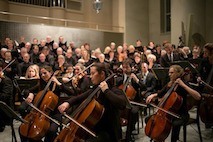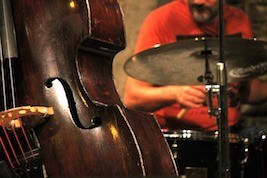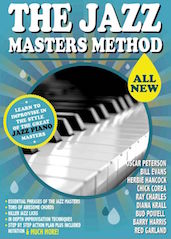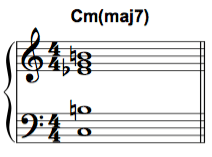Harmonic Minor Scale: Five Jazz Piano Tricks
 Want to learn how to use the harmonic minor scale in your improv?
Want to learn how to use the harmonic minor scale in your improv?
You’ve come to the right place.
In this tutorial, you’ll discover new soloing ideas, chords and everything you need to know about the harmonic minor scale.
This will make your performance more interesting for you and your listeners.
Let’s get started.
1. How To Use The Harmonic Minor Scale Like Django Reinhardt
 Django Reinhardt, king of gypsy jazz guitar, frequently used the harmonic minor scale to great effect in his solos.
Django Reinhardt, king of gypsy jazz guitar, frequently used the harmonic minor scale to great effect in his solos.
Check out this improvisation over the Django tune “Minor Swing” by pianist Peter Beets:
Despite all the embellishment, the harmonic minor scale forms the backbone of Peter Beets’ solo.
In A minor, the scale looks like this:

A – B – C – D – E – F – G#
The melody towards the end of “Minor Swing” is a derivative of A harmonic minor in the form of a i – iv – V chord progression in arpeggios:

Notice how all the notes of A harmonic minor are distributed over those chords?
So, from a jazz piano perspective, here are a few items you can use for improv over minor chords with this scale:
- Break up the harmonic minor scale up into chord tones (since each of the chords in a minor key get their notes from it).
- Use chromatic embellishments to connect one chord tone to the next.
From these two, you can already generate a lot of soloing ideas.
However, the fact remains that you can do so much more with one scale. Find out more below.
2. How To Use The Harmonic Minor Scale Over A Dominant 7th Chord
 You may say, “Wait! Doesn’t a dominant seventh chord contain a major triad? And aren’t we talking about a MINOR scale? How’s that going to work?”
You may say, “Wait! Doesn’t a dominant seventh chord contain a major triad? And aren’t we talking about a MINOR scale? How’s that going to work?”
Here’s how it will work:
First, don’t use the harmonic minor scale based on the root note of your dominant seventh chord. That doesn’t really work well.
Second, use the harmonic minor based on the 4th note above the root of your dominant 7th chord.
For example, you can use your C harmonic minor over a G7 chord.
Here’s a riff I came up with that uses this jazz scale over a G7 chord:

To be more technical about it, the harmonic minor is in it’s fifth mode a.k.a. the Phrygian Dominant Scale.
Sounds exotic, right?
Matter of fact, famous jazz legends like Miles Davis have used this scale to great effect in their music.
Here is one example:
 Speaking of grabbing more ideas and inspiration from legends, the Jazz Masters Method is the perfect place to start.
Speaking of grabbing more ideas and inspiration from legends, the Jazz Masters Method is the perfect place to start.
Inside the Jazz Masters Method, you’ll discover a step-by-step exploration of 9 different legendary jazz piano players and their improvisation concepts.
This will certainly help you express your ideas in clear and interesting ways.
Get instant access to the Jazz Masters Method here.
Now that you have an idea about how to use harmonic minor in melodies and solos, let’s try grabbing some chords from the harmonic minor scale.
3. Let’s Instantly Grab A Chord From The Harmonic Minor Scale
 Did you know that you can actually use three scales over any minor key? These are natural minor, melodic minor, and harmonic minor.
Did you know that you can actually use three scales over any minor key? These are natural minor, melodic minor, and harmonic minor.
This is the edge of minor keys over major. This opens up a lot of colorful possibilities.
The harmonic minor scale was invented so that you can have a V7 chord in a minor key.
Whenever you’re playing something like Autumn Leaves or Stella By Starlight, you have these ii(b5) – V – i chord progressions.
To see how much impact the harmonic minor scale has over harmony, watch and listen to the video below. There are 2 parts.
The 1stexample is a 2-5-1 chord progression based on the natural minor scale. The second example is still a 2-5-1, but this time it’s based on the harmonic minor scale:
Can you hear how the notes move smoothly from one to another with the ii(b5) – V – i chord progression?
That dominant 7th chord naturally occurs in the harmonic minor scale. The scale was practically invented so you will have a dominant 7th chord in a minor key.
That dominant 7th chord is thus a must-have chord in your arsenal.
However, it doesn’t stop there. Matter of fact is that you can start grabbing a lot more than just the staple dominant 7th chord.
4. How To Grab Even More Chord Voicings
 Now let’s say you’re on the i chord. In the natural minor scale, you’ll have a Cm7.
Now let’s say you’re on the i chord. In the natural minor scale, you’ll have a Cm7.
If we use the harmonic minor scale as basis, we’ll get instead a Cm(maj7) chord.
This “weird” minor-major 7th chord is actually one of Steve’s favorite chords.
Minor-major 7th chords are simply minor triads plus the note a major 7th from the root.
Here’s the Cm(maj7) chord in root position:

Now let’s take that up a notch and run the chord through its inversions with the right hand like this:

How about we add a 9th to that? Let’s see how that works out:

Let’s try adding the 11th this time:

By exploring the scale this way, you can get a lot of chord voicings out of one chord.
This will instantly add variety to your music.
Now, moving on to a different chord, how about our dominant 7th, G7?
Let’s run G7 and G7sus4 chord voicings throughout C harmonic minor:

It’s just like pulling out a rabbit from a hat.
 By the way, If you want to learn even more ways of grabbing interesting chord voicings from scales, the Jazz Improvisation Super System teaches this and much more.
By the way, If you want to learn even more ways of grabbing interesting chord voicings from scales, the Jazz Improvisation Super System teaches this and much more.
Inside the Jazz Improvisation Super System, you’ll discover David Garfield’s tricks for creating endless improvisations over the coolest chord progressions and jazz songs in the world.
And now you have a bunch of interesting chord voicings for your dominant 7th chord.
This time, let’s go back to soloing by tinkering around the scale a bit more.
5. Why Adding More Notes To Scales Make Your Solos More Exciting
 The thing about something so novel is that if it’s used too much, it can get tiring.
The thing about something so novel is that if it’s used too much, it can get tiring.
The same thing goes for our scale.
However, if we tinker around it a bit and add a note or two in between, it brings out a similar yet different flavor.
For example, if we add a b7, we now have a C bebop harmonic minor scale:

C – D – Eb – F – G – Ab – Bb – B
How about we add A natural to the harmonic minor scale? Now we have a C bebop melodic minor:

C – D – Eb – F – G – Ab – A – B
Let’s say we turn that F into F# in our harmonic minor. What do we get?
We now have something called a C Hungarian Minor scale:

C – D – Eb – F# – G – Ab – B
Want to expand it even more? How about trying all of these scales over a G7 chord?
This is what we get for the 5th mode of C bebop harmonic minor:

G – Ab – Bb – B – C – D – Eb – F
How about the 5th mode of C bebop melodic minor:

G – Ab – A – B – C – D – Eb – F
Here’s a more exotic sounding one: The 5th mode of our Hungarian Minor is what’s called a double harmonic scale:

G – Ab – B – C – D – Eb – F#
Congratulations! By working out your harmonic minor scale this way, you have effectively built up your vocabulary.
But what use is all that vocabulary if you can’t use it effectively?
How To Turn Your Techniques Into Better Music
 Do you feel like you’ve hit a wall in your playing?
Do you feel like you’ve hit a wall in your playing?
Are there times at the piano when you felt nothing but anguish and hopelessness?
Maybe you’ve even spent a fair amount of time practicing but you still can’t really express yourself fully at the piano?
You’re not alone. That’s exactly why we created the Jazz Inner Circle 1 on 1 mentorship program.
 Would you love to have a world-class jazz piano mentor work with you 1 on 1 to help you achieve your musical goals? Want to break free of your current musical limitations and have a proven piano superstar walk you by the hand to do this?
Would you love to have a world-class jazz piano mentor work with you 1 on 1 to help you achieve your musical goals? Want to break free of your current musical limitations and have a proven piano superstar walk you by the hand to do this?
Then I encourage you to apply for the program right here.
Inside the Jazz Inner Circle, you’ll discover:
- “The Ultimate Jazz Workout Training System.” This is where we implement a complete practice program to build your jazz piano talent in record time.
- Access to over 50 hours of our high-level jazz intensive workshops.
- And much more.
Slots inside the Jazz Inner Circle are limited. Apply to have us train you 1 on 1 right here.
We also hope that you enjoyed this harmonic minor scale lesson.
If you have questions or anything to add to the discussion, feel free to leave a comment in the section below.
As always, we have your back in your jazz piano journey so keep on learning, keep on practicing. And let’s make some great music!
